Kinderdijk or Zaanse Schans?
You’re visiting Holland, so of course, you want to see windmills. While windmills dot the countryside all over the Netherlands, Kinderdijk and Zaanse Schans are two popular places for viewing windmills and seeing inside them.
[Last updated October 24, 2025]
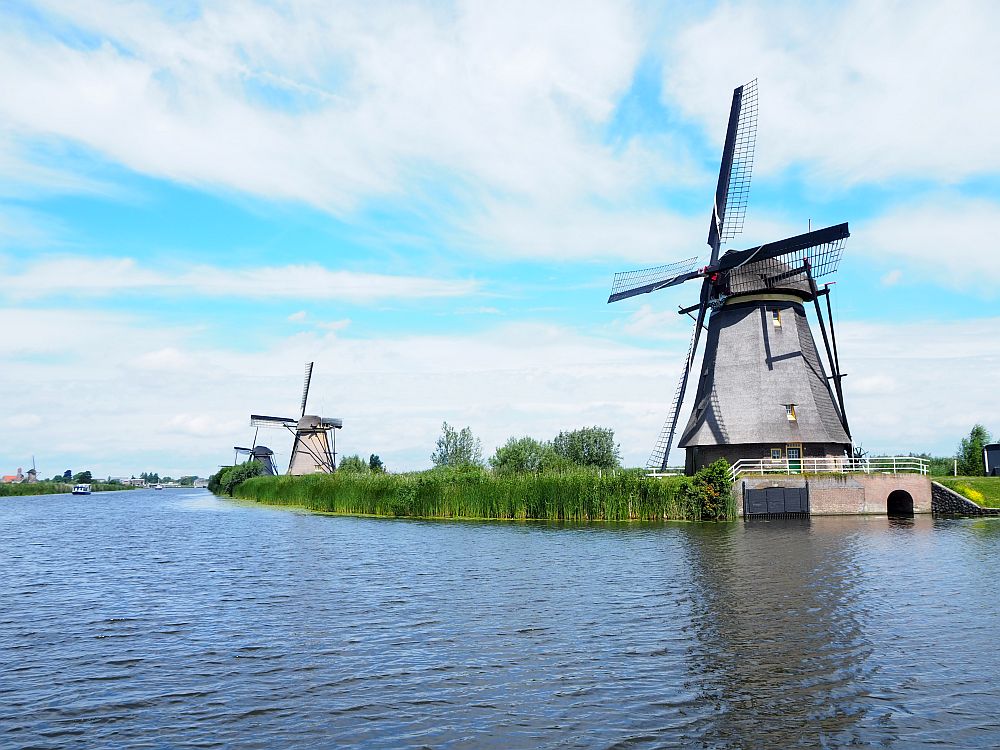
I’ve written about a visit to Zaanse Schans before. North of Amsterdam, Zaanse Schans has a collection of six windmills along the Zaan River, as well as five small museums. You can read my Zaaanse Schans article here.
Disclosure: This article contains affiliate links. If you click on any of them and make a purchase, I will receive a small percentage of what you spend. This will not affect your price.
Below I’ll give you a description of Kinderdijk, along with a comparison of the two, in case you only have time for one or the other.
First, though, go read what I wrote about Zaanse Schans, then pop back here for the rest.
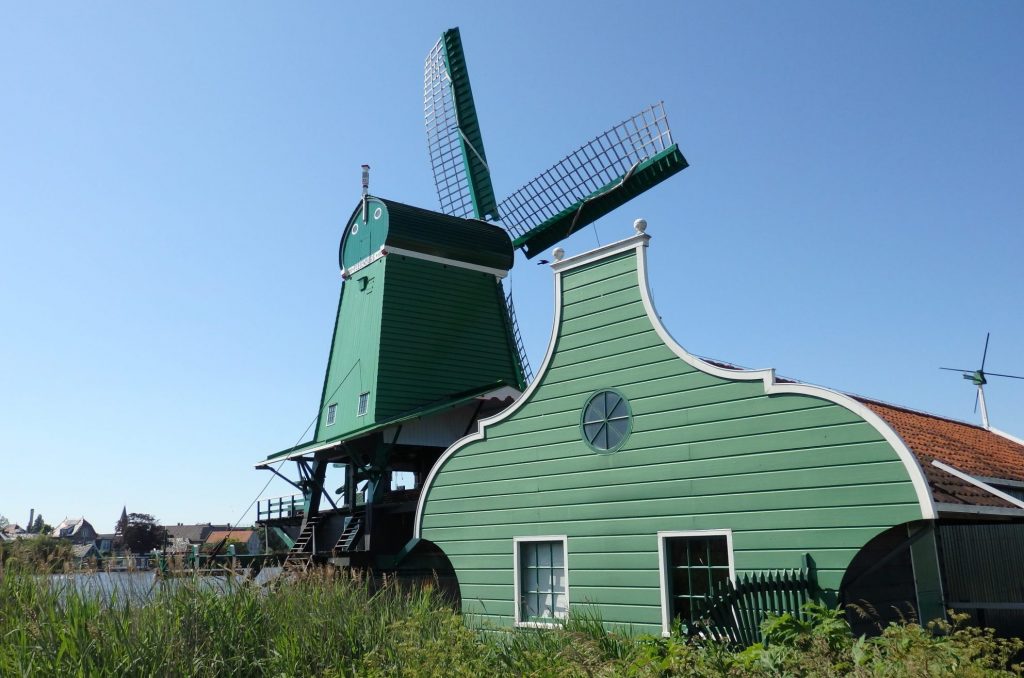
Kinderdijk
Kinderdijk is a UNESCO World Heritage Site because the “outstanding contribution made by the people of the Netherlands to the technology of handling water is admirably demonstrated by the installations in the Kinderdijk-Elshout area.”
In other words, what is celebrated here is a man-made environment: 19 windmills plus pumping stations and sluices, all used to create fields (called polders, which indicates land that is reclaimed from the sea) and to keep the land from flooding.

All of this industrious reshaping of land and water to suit humans’ needs makes for a lovely environment today. Widely-spaced windmills line the waterways. The 10 Overwaard ones, on the left as you enter the site, are octagonal, made of wood and covered in thatch. The 8 mills on the right are the Nederwaard row, made of brick. All were built in the mid 1700s. There is also one smaller hollow post mill called Blokweer, dating to 1630.
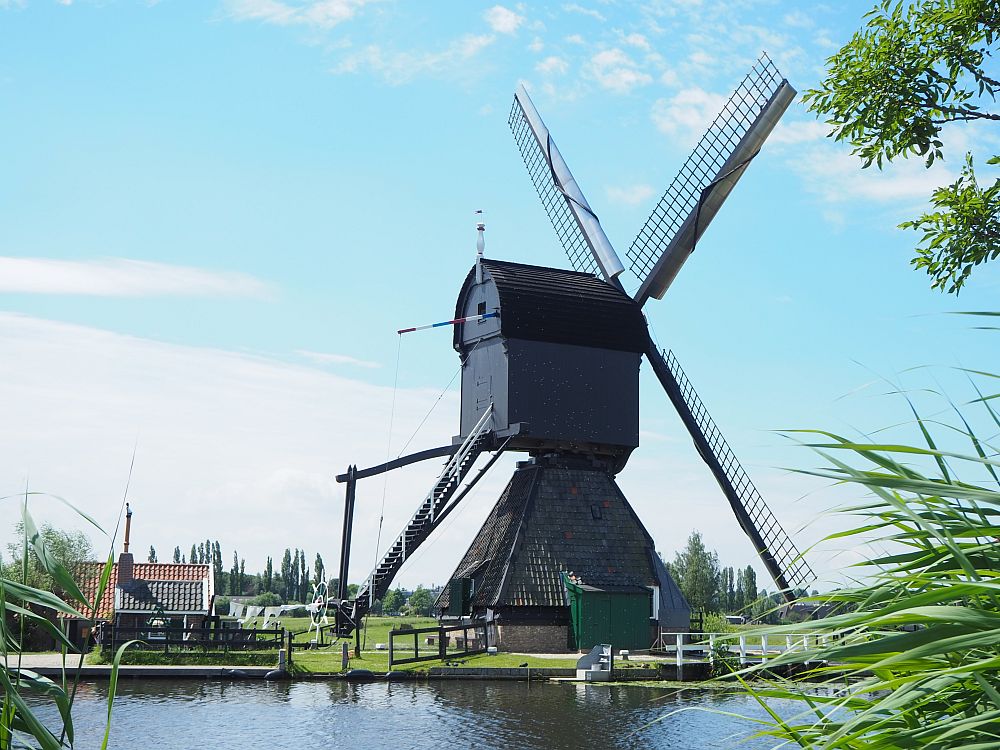
All of the mills are still in working order, and most serve as homes to this day. A few of the families have been millers for generations. Anyone living in one of these monuments commits to maintaining it and operating it a certain number of days per year. Modern pumps (steam, then diesel, then electric) have replaced them in function, though they can still be used as backup if the modern systems fail.
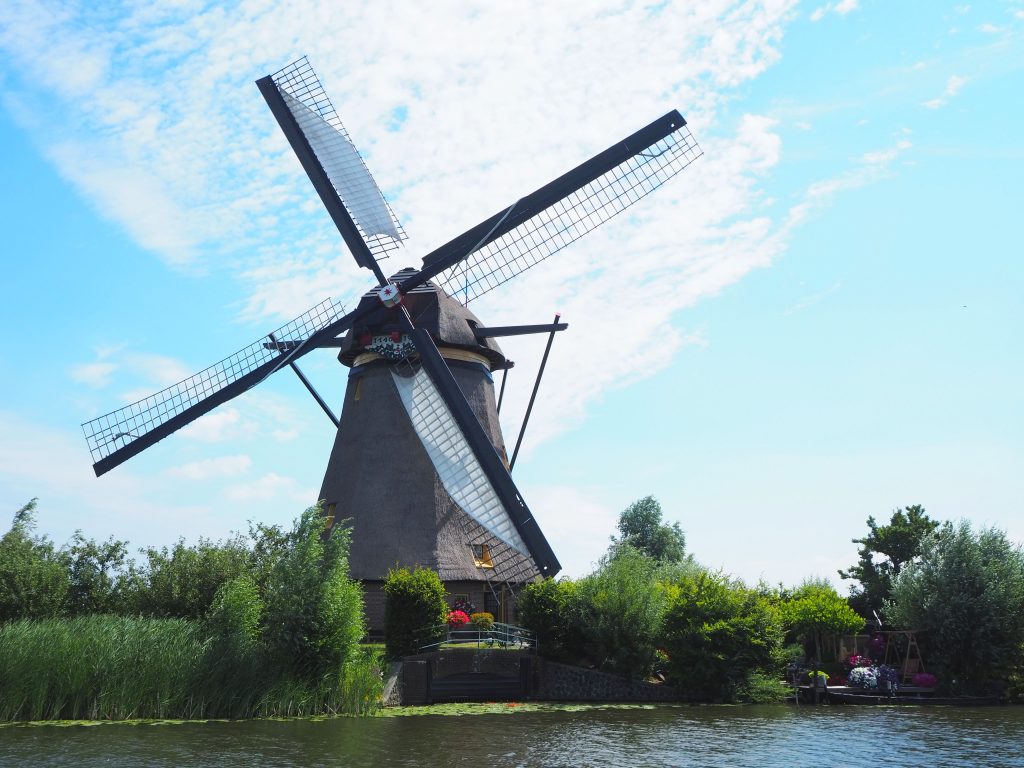
Inside the Kinderdijk windmills
Only a few of the mills are open to visitors at Kinderdijk, which makes for some crowds.
The Nederwaard museum mill is furnished inside as it was when a miller named Hoek operated it and lived inside it, along with his wife and 13 (!) children.

In the Overwaard museum mill, (not always open) you can learn more about how a scoop pump mill works.
The Blokweer museum mill and the yard around it looks at the life of a miller in the 1950s.
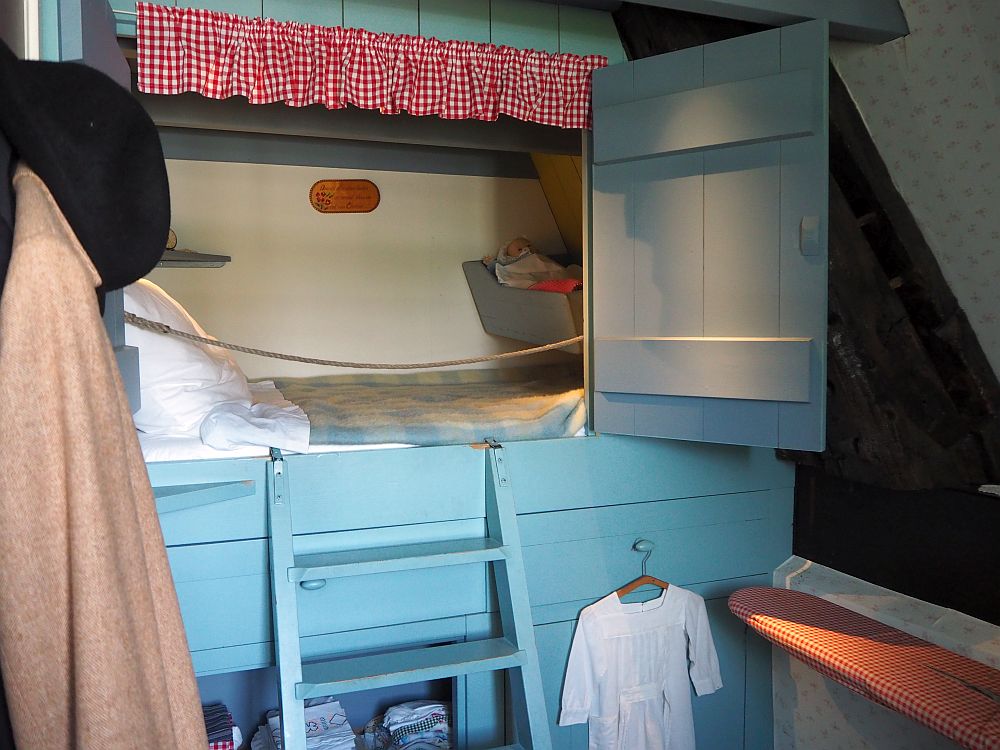
Also at Kinderdijk are more modern pumping stations and displays explaining how the land was created and how pumps continue to keep it dry.
The windmills are quite spread out along the waterway. Small boats ferry passengers across or from one end to the other, and the views from the water are definitely worth the boat ride.
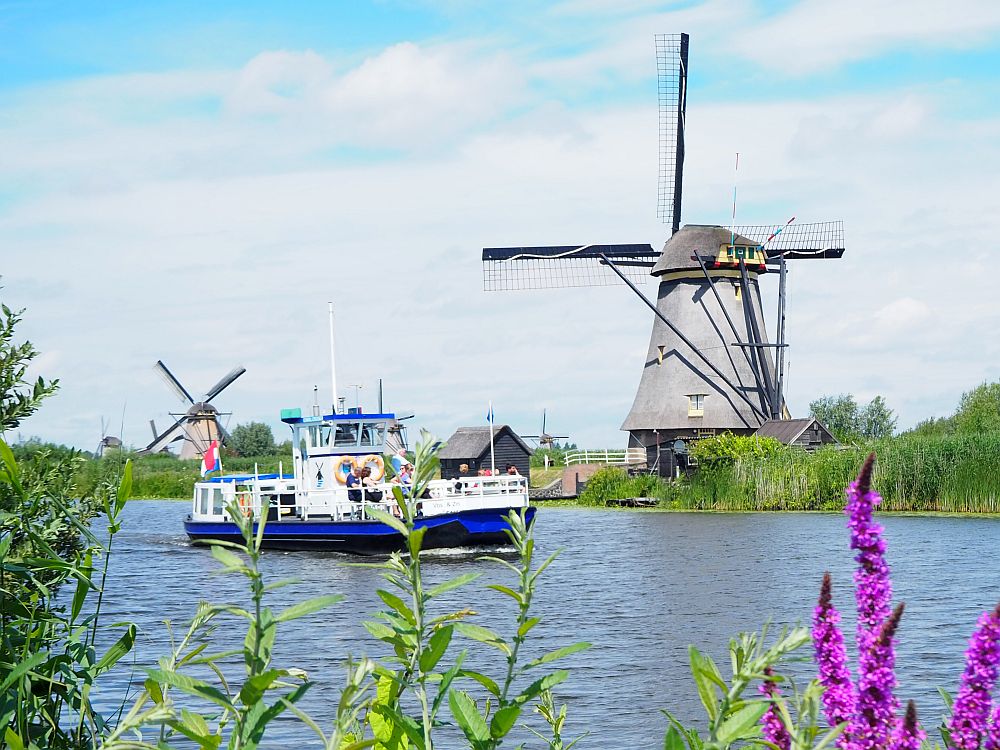
Visiting Kinderdijk
From Amsterdam it would be easiest to take a tour. Here are a few suggestions:
- Try this full-day private tour of Kinderdijk and other sights.
- Or focus on taking great pictures on this photography tour.
- Or get active on a guided bike tour of Kinderdijk.
If you’ve rented a car from Schiphol, you can drive there in about two hours (barring traffic jams).
There are ways to get to Kinderdijk via public transportation from Amsterdam or Rotterdam but none of them is straightforward and they all involve changing trains/trams more than once.
From Amsterdam, you need to get to Rotterdam Central Station first, then take metro D to Zuidplein. From there, take bus 190 to Kinderdijk. Alternatively, in Rotterdam you can take the WaterShuttle from Erasmusbrug during the summer. The rest of the year you’d get off at Ridderkerk and catch the Driehoeksveer ferry from there. Book tickets for the WaterShuttle.
Kinderdijk: Nederwaard 1b, Kinderdijk. If you’re driving, the address is Marineweg 3 in Alblasserdam. Open March-October daily 9:00-17:30 and November-December daily 10:30-16:00. Pre-order your tickets or buy them at the entrance. Tickets include the museums and a boat ride.
The paths, the boat and the exhibits about modern pumping are all wheelchair-accessible. The mill museums are not.
Book your accommodations in the Netherlands through Booking.com or Expedia, or use the map below. It’s centered on Amsterdam, but just zoom out or drag the map to see other parts of the country.
If you’re going to be in Rotterdam, take a look at my article about the city’s art and architecture. You might also enjoy this article I wrote about the Dutch and their attitude toward water: Watery Hubris.
Zaanse Schans or Kinderdijk?
Crowds
While both Zaanse Schans and Kinderdijk can get quite crowded, it’s generally busier at Kinderdijk. Since only a few of the mills are open to visitors, you may have to wait in line to enter, as I did, after busloads of tourists.
In both places there are ways to avoid the worst of the crowds: go early in the morning, or go straight to the furthest end where the crowds will be thinner. Towards the end of the day you’ll get fewer people in general and also have better light for your photos. Weekdays are generally better than weekends, and spring and fall are better than summer.
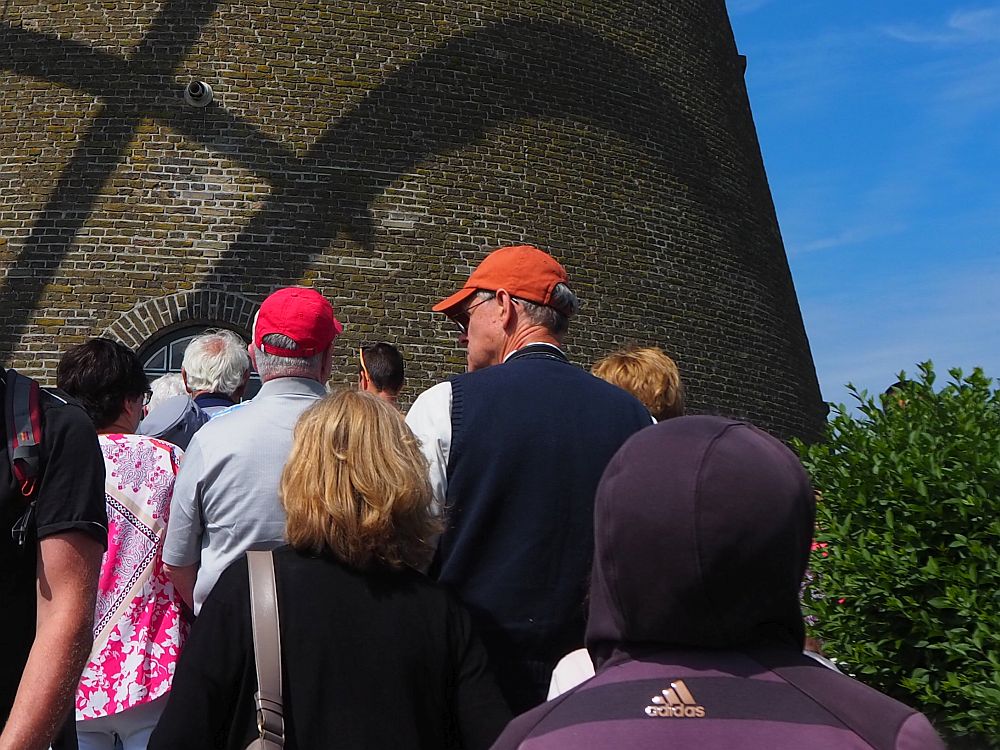
Number of windmills and authenticity
Kinderdijk is special because of the sheer number of windmills (19) and the fact that they are still in their original place and used for their original function. Zaanse Schans, on the other hand, has only six windmills, and only two were originally there.
Windmill functions
On the other hand, at Zaanse Schans you’ll see more variety: a mustard mill, two sawmills, a paint mill, and two oil mills (flaxseed and peanut). Each has a different architecture as well and their age varies too. At Kinderdijk, the mills all do the same thing: move water off lower land into higher bodies of water.
At the same time, you will only learn about land reclamation and water control – an extremely serious topic in a country that is largely below sea level – at Kinderdijk, not at Zaanse Schans.
In both places, the mills are in working order, and you’ll be able to see them in operation if you visit on a weekend and there’s enough wind.
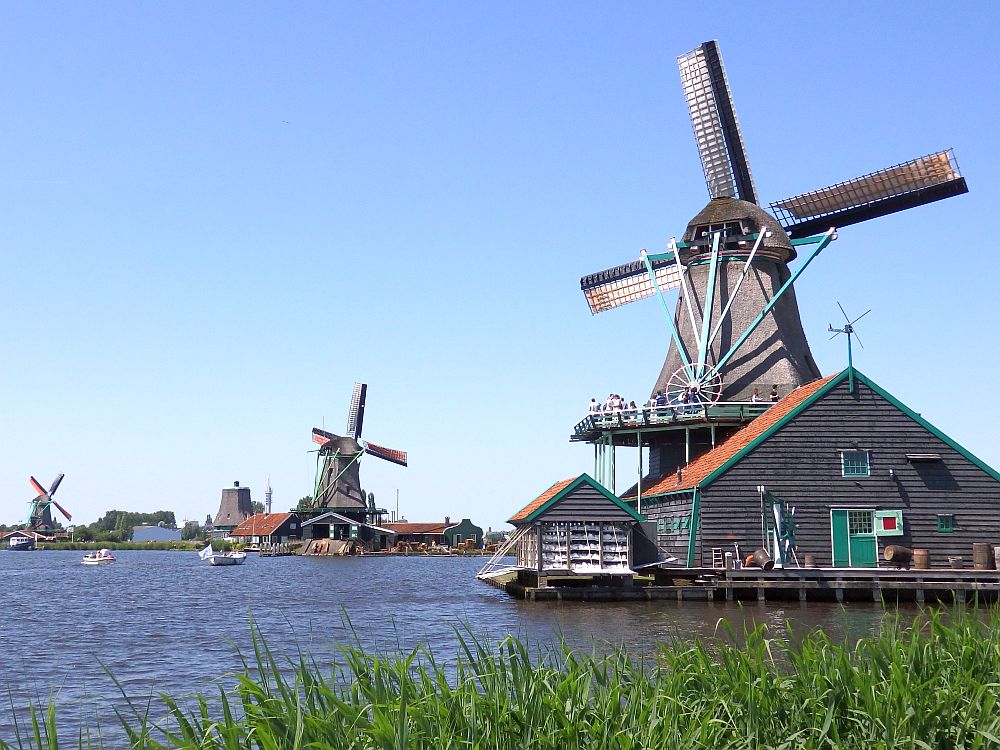
Seeing inside windmills
Assuming you visit when they’re open, you can enter more windmills at Zaanse Schans than at Kinderdijk. Both complexes have other elements to see: little crafts museums and historical buildings at Zaanse Schans, information on water control at Kinderdijk.
Locations
Kinderdijk is about two hours south of Amsterdam and one hour from Rotterdam. Zaanse Schans is about a half hour north of Amsterdam, making it an easier, quicker trip if you’re visiting Amsterdam.
If you’re going to spend time in Amsterdam, take a look at my series on small museums and other sights to see in Amsterdam.
So, will it be Kinderdijk or Zaanse Schans?
Despite the fact that Kinderdijk is UNESCO-listed and Zaanse Schans is not, I prefer Zaanse Schans. While both places are pleasant to visit and offer pretty views, I like the variety at Zaanse Schans, and the opportunity to enter more windmills (when they’re open) and even see them in operation.
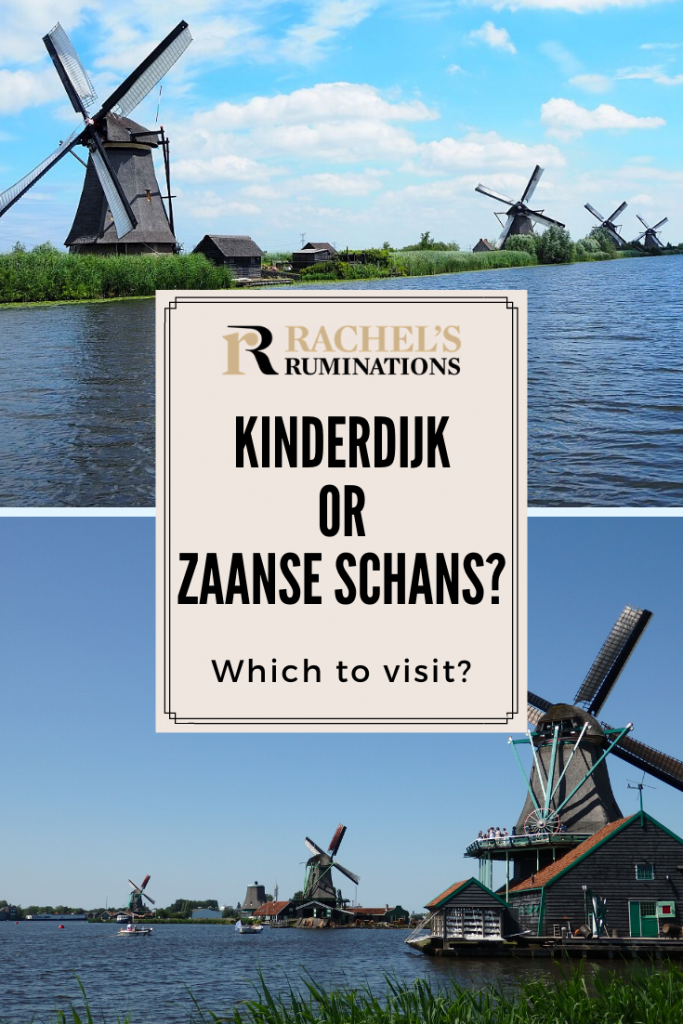
Have you been to either one or both? Tell me about your experience in the comments below!
My travel recommendations
Planning travel
- Skyscanner is where I always start my flight searches.
- Booking.com is the company I use most for finding accommodations. If you prefer, Expedia offers more or less the same.
- Discover Cars offers an easy way to compare prices from all of the major car-rental companies in one place.
- Use Viator or GetYourGuide to find walking tours, day tours, airport pickups, city cards, tickets and whatever else you need at your destination.
- Bookmundi is great when you’re looking for a longer tour of a few days to a few weeks, private or with a group, pretty much anywhere in the world. Lots of different tour companies list their tours here, so you can comparison shop.
- GetTransfer is the place to book your airport-to-hotel transfers (and vice-versa). It’s so reassuring to have this all set up and paid for ahead of time, rather than having to make decisions after a long, tiring flight!
- Buy a GoCity Pass when you’re planning to do a lot of sightseeing on a city trip. It can save you a lot on admissions to museums and other attractions in big cities like New York and Amsterdam.
Other travel-related items
- It’s really awkward to have to rely on WIFI when you travel overseas. I’ve tried several e-sim cards, and GigSky’s e-sim was the one that was easiest to activate and use. You buy it through their app and activate it when you need it. Use the code RACHEL10 to get a 10% discount!
- Another option I just recently tried for the first time is a portable wifi modem by WifiCandy. It supports up to 8 devices and you just carry it along in your pocket or bag! If you’re traveling with a family or group, it might end up cheaper to use than an e-sim. Use the code RACHELSRUMINATIONS for a 10% discount.
- I’m a fan of SCOTTeVEST’s jackets and vests because when I wear one, I don’t have to carry a handbag. I feel like all my stuff is safer when I travel because it’s in inside pockets close to my body.
- I use ExpressVPN on my phone and laptop when I travel. It keeps me safe from hackers when I use public or hotel wifi.




Hi Rachel,
What a joy to be here today!
Glad that we met today at Linkedin. 🙂
From there I am here. Wonderful and lovely share.
Indeed these eye-catching scenes made my day!
Keep sharing.
All the best.
~ Phil
Nice comparison, good job. Been to both many times, and I agree that Zaanse Schans is a bit more interesting. I used to work for the shipyard located right by the Kinderdijk mills and I could admire them every single day, but that does not influence my choice. I think there is more to do in Zaanse Schans. Still, Kinderdijk is a nice place to visit, especially if you are staying in Rotterdam. It is also nice that you can travel there with the affordable ferry
Now this is such a helpful post – you are really explaining the differences so well! From your pix, however, both places look really beautiful and I would have thought that it’s calmer to visit Kinderdijk. However, I guess you’re right that the variety at the Zaanse Schans ist greater. Hm, maybe I just should visit both – I don’t live that far away, after all.
Kinderdijk has a calm look to it and a pretty environment to walk through, but then so does Zaanse Schans. I’m not happy in crowds, and I’ve experienced both on crowded days. I guess it was easier to get away from the crowds at Zaanse Schans by just heading for the furthest windmill first.
The windmills standing by the waterways in Kinderdijk evoke scenes from a fairy tale. They look so beautiful. But yes, apart from their cosmetic value, they stand as testimony to the ingenuity and resourcefulness of the people. I can understand why you prefer Schans over Kinderdijk, as that is where one can really appreciate and enjoy the windmills in a more leisurely and relaxed manner with lesser crowds.
The first time i came across the names of these town, when i was editing a gust post about a 7 Day Netherlands Itinerary to go live on my blog. The windmills caught my interest, but want able to read much in detail at that time. Really enjoyed going through this, and both Kinderdijk and Zaanse Schans are on my radar. Your tip about more varieties being there at Zaanse Schans is highly appreciated.
How lovely! I have never heard of either Kinderdijk or Zaanse Schans, but I’ve always wanted to go to Holland. Now I can’t go without seeing one of these places! I appreciate your comparison, I think I’d go to Zaane Schans with your recommendation!
Both look wonderful, but I think I’d have to go for less crowded Zaanse Schans over Kinderdijk as well. Being able to see different varieties of mills at Zaanse Schans sounds really interesting. Lovely photos by the way, it seems you had the perfect weather for your visit.
Yes, I did!
Such an interesting post! We’ve often taken people to Zaanse-Schans, but have not yet seen Kinderdijk – thanks for getting it on our radar!
Its Zaanse Shans for me! All of the windmills are gorgeous, but I would want to go inside. I have never been in one yet.
You can go inside a couple of the windmills at Kinderdijk too. But if you want to see how different ones work for different purposes, then yes, Zaanse Schans is the better choice. Check their website for when they’ll all be open, since they’re all independently-run.
What a fun walk through the windmills. We have never visited this region, but I believe we would lean toward the Kinderdijk windmills. It would be so much fun to explore them inside and out. Of course, that boat tour would be an additional vantage point to help get a complete picture.
Good point, though there may also be boat rides available at Zaanse Schans sometimes. I’m not sure.
It is worth mentioning that the mills in the two cities are totally different in purpose! Kinderdyk lifts water from one level to a higher level in stages and all are based on use of an Archimedean screw to lift water while powered by wind. The second most interesting thing is the name: based on the story of a cat who kept a child alive by balancing on a cradle during a huge flood centuries ago. I have never seen it. Zanse schans is itself a museum of mills. One lifting water I think but also a mill to grind mustard seed, to saw wood into boards, grind paint pigments or salad oil; as different in purpose as a Doberman is from a miniature poodle!
All true! I didn’t know that story of the name of Kinderdijk, though! Zaanse Schans, besides a range of windmills, has some other historical buildings as well.
So, do we really have to choose?
Haha! Of course not! I didn’t!
Interesting post. I’ve been to the Kinderdijk windmills and loved exploring there. Didn’t know about the ones at Zaanse Schans. I’m planning a trip early next year to Amsterdam, so as not too far away I may pay a visit.
Go for it! You won’t regret it and it’s much nearer!
I spent two weeks in Jan-Feb this year in Amsterdam. Loved the city and took a day off to visit Zanse Schans. Couldn’t stop shooting the Kinderdijk windmills and tasting the local cheese. Oh I miss those days!
Did you go to Zaanse Schans or Kinderdijk? Or both? And yes, the cheese!
Yes, I must see the Windmills. I aim to see Amsterdam via the Eurostar and now the windmills. Thanks for sharing.
I’ve been to Kinderdijk and enjoyed the visit. Now I have another bucket list item for my next trip to the Netherlands–Zaanse Schans!
Kinderdijk in the snow December 2010, was a memorable visit!
It must have been! Given how little snow we get these days, that’s a sight very few people ever see!